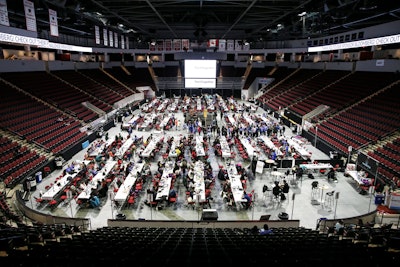
Matt Williams is the chief creative officer at Kindle Communications.
Businesses need their people to be connected by cause and driven by effect. They need advocates and engaged stakeholders willing to do whatever it takes to make new possibilities the new realities.
Live touchpoints of any scale can be big opportunities to move the most vested groups of people in an organization to take action around a new brand, product, service, or business strategy. In fact, 65 percent of people have said that events and product demonstrations improved their understanding of a product better than any other method could. But if your event isn’t designed to meet people’s evolving communication preferences and experiential needs, then that statistic might not be true for long.
The mix of people in an organization is quickly shifting, and so are its habits. According to Intermedia’s 2018 Workplace Communications report, Millennials and gig economy workers are taking the workplace mobile: 51 percent of survey participants said they conduct workplace communication via email, phone, or mobile app before they even reach the office. According to Forbes, the workforce’s younger employees are shifting leadership models as well.
What does that mean for live events? It means they have to shift, too. And the biggest change will be to the mindsets of those responsible for the content and production or the event—on both the client and agency sides. As for those who will be in the audience, it’s mostly a shift in expectations. Some might grumble. The majority will rejoice.
Think back to the last few events you’ve attended or produced, and ask yourself: Is the audience idly standing by as a group of passive attendees waiting for seemingly endless sermons and keynotes to end? Or are they active participants at every turn of the experience, truly fueled by a sense of ownership and the ability to make change happen?
Using live touchpoints to simply throw information at your eventgoers is a mistake. And calling a Q&A segment “participation” just doesn’t cut it. Instead, here are three shifts you should focus on while planning your next event and the strategies you need to succeed:
1. From passive attendees to active participants.
Self-expression and personalization are the new norms across the content creation spectrum. People are now used to being content creators themselves and using peer-to-peer networks to share their viewpoints and connect with like-minded individuals. Empower people to participate fully in your events—influencing both the overall experience and each other.
Don’t expect people to be comfortable sitting still or to absorb heavy content as a passive, idle listener. Instead, make your content digestible and the entire experience completely customizable. Adding that element of customization could help attendees learn and retain information as well; according to ongoing research, personalized learning strategies can lead to levels of increased success in various subjects.
2. From a finite event to an ongoing experience.
It’s easy to become hyperfocused on all the intricacies, competing priorities and messages a live event includes. But for the audience, community, and communication go well beyond the time and space that a live event exists within. It’s a blip on the calendar for them. And then what? What else can they explore? Understanding how a live touchpoint fits into a bigger conversation is key to crafting the experience itself, then giving it the legs to be something more enduring and meaningful. Otherwise, your event (and R.O.I.) will quickly disappear for most attendees.
Maximizing the value of a live event doesn’t mean focusing on the event alone. Consider what you can do with your audience before the event to maximize the time attendees spend together in person. Use the metrics and preferences you gather before and during an event to create new, sustainable, self-moderated communities of interest (online or off) afterward. And use everything you’ve learned to plan even more successful live experiences in the future.
3. From building alignment to reaching a common understanding.
Every person has a unique way of learning new information. We all have different personalities and perspectives. We’re naturally curious and skeptical. And according to a BBC and Ipsos survey, more than three-quarters of the global population believes their countries are divided. That said, it is both possible and critical to find ways to reach a sense of collective agreement with a genuine appreciation for the different thoughts and contributions of each individual. These differences can spark innovation.
For example, hackathons—like the AI for All Global Hackathon just announced in India—represent this exact type of thinking. Each participant faces the same goal and challenge. There are different ways to solve it, but they’re all motivated by the same mission.
If you don’t want your audience members to simply sit through your next event and forget it as soon as they leave, you must embrace the immediate, personalized, and social communication preferences they embrace. Your attendees and their behaviors should be the driver of your entire event. If they aren’t, you’re not driving results.
With these strategies in mind, you can work to keep engagement levels high before, during, and after every event to maximize R.O.I. and relevance.



















